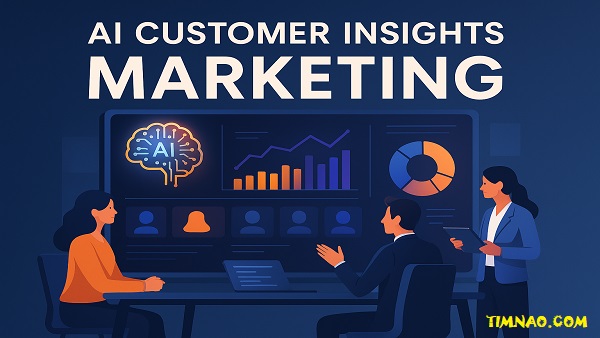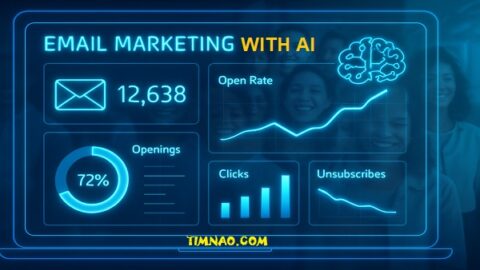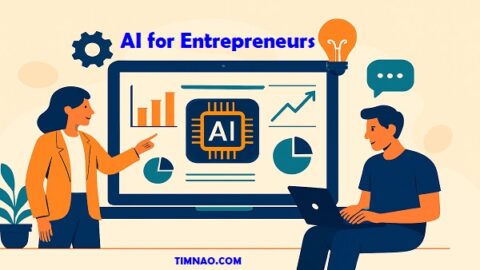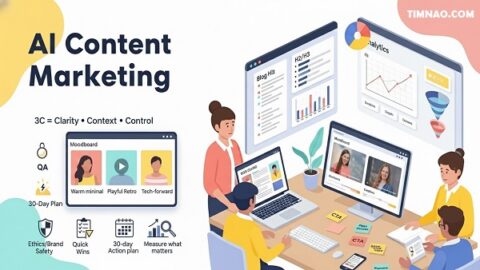Why Smart Brands Love AI Marketing (And Why Some Hate It) 🤖
AI customer insights are no longer reserved for tech giants with massive budgets. Today, even small businesses and solo entrepreneurs can harness the power of artificial intelligence to truly understand what their customers want — and deliver it before they even ask.
Imagine knowing which products your customers are likely to buy next, what content will get the most clicks, or when someone is about to churn — and having the tools to act on that knowledge instantly. That’s the promise of AI in marketing — and it’s already revolutionizing how brands connect, convert, and grow.
But here’s the truth: diving into data-driven marketing can feel overwhelming, especially if you’re just starting out. There’s a lot of jargon, a flood of tools, and a constant pressure to “keep up.”
That’s why we created this beginner-friendly guide — to demystify the world of AI-powered customer insights, explain how it works in plain English, and show you exactly how to get started (ethically and effectively).
Whether you’re curious, cautious, or ready to dive in headfirst, this guide will help you turn AI from a buzzword into your marketing superpower.
📚 Table of Contents
- 🔍 What Are AI Customer Insights and Why They Matter
- 📊 From Gut Feelings to Data Power: The Rise of Data-Driven Marketing
- 🧬 Types of Data AI Uses (And Why You Need All Four)
- 🛠️ Collecting & Cleaning Data the Smart Way
- 👥 AI-Powered Segmentation: Know Your Audience Like Never Before
- 🧠 Predicting the Future: Behavioral Analysis & Personalization
- 🚨 Ethics & Privacy: How to Use AI Responsibly
- 🏁 Final Thoughts: Embrace AI, But Do It Smartly
🔍 What Are AI Customer Insights and Why They Matter
In today’s hyper-connected world, marketing has evolved far beyond catchy slogans and clever ads. It’s now a data game — and AI customer insights are rewriting the rules. Whether you’re running a startup, a local business, or a global brand, understanding your customers is everything. But here’s the truth: traditional methods like surveys and spreadsheets just don’t cut it anymore.
Enter AI-powered customer insights — tools and algorithms that help marketers collect, process, and interpret mountains of data in seconds. Instead of relying on intuition, companies can now predict customer behavior, personalize experiences, and automate decisions with a level of precision that was impossible a decade ago.
So why should beginners care? Because tapping into these tools isn’t just for tech giants anymore. Even solopreneurs and small brands can harness the power of AI in marketing to make smarter decisions, spend less on ads, and connect with their audience on a deeper level.
Here’s the big idea: AI doesn’t just tell you what your customers did. It tells you what they’re going to do next — and how to keep them coming back.
📊 From Gut Feelings to Data Power: The Rise of Data-Driven Marketing
For decades, marketing was driven by guesswork, instincts, and the occasional focus group. But as digital tools matured, data took center stage. We saw the rise of web analytics, customer relationship management (CRM) systems, and email tracking. Yet even then, most of that data was reactive — it told you what already happened, not what’s next.
Now, with AI customer insights, marketing has become predictive and even prescriptive. That means your systems don’t just analyze — they recommend. They act. They adapt in real time.
The Evolution Timeline:
- Old School: “Let’s run a focus group and see what people say.”
- Digital 1.0: “Look at these analytics — we had a 5% bounce rate improvement.”
- AI Era: “This segment of users will likely churn next week — let’s send a retention email today.”
With the help of machine learning and automation, data-driven marketing has matured into a proactive, AI-powered discipline. You no longer have to wait until a campaign fails to fix it. AI tells you in advance what’s likely to happen — and how to steer it in the right direction.
🧬 Types of Data AI Uses (And Why You Need All Four)
AI is only as smart as the data it learns from. The more high-quality data you feed it, the better your insights — and the more accurate your predictions. But not all data is created equal. To truly benefit from AI in marketing, you need to understand the four types of customer data:
1. First-Party Data
This is gold. It’s data your business collects directly from customers — like email signups, past purchases, or website behavior. It’s accurate, compliant, and trustworthy.
💡 Example: Knowing that a customer browsed red sneakers twice last week? That’s first-party data.
2. Second-Party Data
This is someone else’s first-party data, shared via partnerships. Think of it as strategic data sharing — you get access to valuable insights from another company (with consent, of course).
3. Third-Party Data
This data is bought from outside providers. It’s broader and useful for reaching new audiences, but often less accurate and increasingly restricted due to privacy laws.
4. Zero-Party Data
This is the future. It’s data customers willingly share — like preferences in a quiz or feedback in a survey. It’s highly reliable and builds trust.
🧠 Pro tip: As cookies disappear, focus on collecting more first- and zero-party data through owned channels.
Structured vs. Unstructured Data
It’s not just what data you have — it’s how you organize it.
- Structured data is neat and tidy: numbers, dropdowns, dates.
- Unstructured data is messy but rich: social media posts, customer reviews, voice messages.
AI excels at making sense of unstructured data. With tools like natural language processing (NLP) and image recognition, marketers can now tap into emotional signals, trends, and even sarcasm — automatically.
🛠️ Collecting & Cleaning Data the Smart Way
You’ve got data pouring in from your website, social media, emails, and even smart devices. But here’s the thing: raw data is messy. Without structure or cleanup, it’s just digital noise. That’s why smart data collection and preprocessing is the foundation of effective AI customer insights.
Whether you’re a beginner or scaling a business, learning how to gather and prepare your data will set you apart — because clean, accurate data = better AI performance and stronger marketing results.
Let’s break this down into three critical stages: collecting, cleaning, and protecting your data.
📥 Where Your Data Comes From (And What to Do With It)
AI thrives on rich, diverse sources of data. The more touchpoints you track, the deeper your customer understanding becomes. Here are the most important data sources you should be tapping into:
1. Web Analytics
Tools like Google Analytics, Hotjar, and Adobe Analytics show how users interact with your website. You can track page views, session duration, click behavior, and bounce rates.
💡 How AI uses it: Understand browsing habits, identify popular content, and flag drop-off points in your funnel.
2. Social Media Platforms
From Facebook to TikTok, social data is full of user intent, sentiment, and engagement. Tools like Hootsuite, Sprout Social, or Brandwatch help brands gather and analyze these insights in real time.
💡 How AI uses it: Detect trends, measure sentiment, and personalize social media marketing efforts.
3. CRM Systems
Your CRM (like HubSpot, Zoho, or Salesforce) is a treasure trove of purchase history, email behavior, service tickets, and personal preferences.
💡 How AI uses it: Segment customers, send tailored offers, and trigger automated messages at the perfect moment.
4. IoT Devices
If you sell physical products — think smartwatches, fitness trackers, or home appliances — IoT devices collect real-time behavioral data.
💡 How AI uses it: Understand real-world usage patterns and personalize recommendations based on live input.
🧼 The Not-So-Glamorous But Crucial Step: Data Cleaning
Before feeding data to an AI model, you’ve got to clean it — or risk skewed results, wasted ad budgets, and embarrassing mistakes (like sending promotions to the wrong audience).
Here’s how to clean your data like a pro — even if you’re a beginner.
Common Problems With Raw Data:
- 🧟♂️ Duplicates – One user shows up five times.
- ❓ Missing values – Like an email address without a name.
- 🌀 Inconsistencies – Date formats all over the place.
- 📊 Outliers – A “$1,000,000” cart value from a typo? Yep.
What to Do:
- Remove Duplicates: Use AI or spreadsheet tools to identify and merge repeated entries.
- Fill in Gaps: Use smart defaults or predictive modeling to guess missing values when appropriate.
- Standardize Formats: Unify currency, capitalization, and timestamps.
- Normalize Data: Bring numbers into the same scale so AI doesn’t misinterpret them.
✨ Tools like OpenRefine, Trifacta, or DataRobot make this much easier for non-coders.
🔬 Data Enrichment: Make Good Data Even Better
Once your data is clean, it’s time to enrich it. That means adding extra layers of context to get deeper, more actionable insights.
Examples:
- Append demographic data to email subscribers (e.g., age, city, income bracket).
- Combine weather data with purchase behavior to detect seasonal trends.
- Integrate sentiment scores with product reviews to understand public opinion at scale.
💡 Why it matters: A plain purchase record doesn’t tell you why someone bought. Enrichment helps fill in that emotional and behavioral picture.
Tools like Clearbit, ZoomInfo, and IBM Watson can automate enrichment at scale.
🔐 Security, Privacy & Trust — A Must for Ethical AI
Let’s not sugarcoat it: trust is everything in modern marketing. One privacy scandal can ruin your brand overnight. That’s why businesses — especially those using AI customer insights — must protect user data like gold.
Key Principles for Ethical Data Use:
- Transparency: Tell users what data you collect and why.
- Consent First: Always obtain permission — especially under GDPR, CCPA, or similar regulations.
- Limit Collection: Don’t hoard data you don’t need. Respect data minimization principles.
- Encrypt Everything: From storage to transmission, your data should be secure at every stage.
💡 Apple’s App Tracking Transparency is a great example of putting users first and building trust through transparency.
AI Tools That Help:
- AWS Shield for cloud security
- Google Cloud Security for secure storage
- IBM Guardium for threat detection
✅ Summary: Smart Data = Smart Marketing
Here’s your quick checklist for building a strong foundation for AI marketing:
- ✅ Use multiple relevant data sources
- ✅ Clean and normalize your data before use
- ✅ Enrich it to unlock deeper context
- ✅ Keep it all secure, compliant, and transparent
When done right, this stage sets the tone for everything that follows — from advanced segmentation to personalized customer journeys.
👥 AI-Powered Segmentation: Know Your Audience Like Never Before
In traditional marketing, customers were lumped into big, generalized categories — like “women aged 25–45” or “urban millennials.” But let’s be honest: those labels don’t really tell you much about what a customer wants.
That’s where AI-powered customer segmentation comes in. Using advanced algorithms and real-time behavioral data, AI can divide your audience into incredibly detailed segments based on what they do, not just who they are. The result? Laser-focused marketing that speaks to the individual, not the crowd.
Let’s explore how this works — and why it’s become a game-changer for businesses of all sizes.
🧠 From Demographics to Dynamic Behavior
Old-school segmentation was built around static traits like:
- Age
- Gender
- Income level
- Location
But AI goes deeper — way deeper. It looks at how people act, interact, and react across all digital touchpoints. This behavioral approach leads to hyper-targeted personalization that converts better and builds long-term loyalty.
Key Behavioral Data AI Uses:
- Shopping frequency
- Browsing habits
- Time spent on product pages
- Engagement with emails or social media
- Abandoned carts
- Preferred device or platform
💡 Example: Instead of showing the same ad to every 30-year-old, AI can target “frequent buyers who browse at night and abandon carts with items over $100.” That’s real insight.
⚙️ How AI Segments Customers Automatically
AI uses machine learning to process thousands (or millions) of data points in seconds. It identifies patterns and clusters of behavior that human marketers might miss — or take months to discover.
Here’s how it works in simple terms:
- Data Collection: AI gathers customer data from web visits, emails, purchases, etc.
- Pattern Detection: Algorithms detect similarities and patterns in behavior.
- Segmentation: Customers are grouped into dynamic, behavior-based segments.
- Actionable Output: Marketers use those segments to tailor content, offers, and messaging.
📊 Bonus: These segments constantly update in real-time as customer behavior evolves — no more static lists.
🤖 Supervised vs. Unsupervised AI Segmentation
There are two main types of machine learning AI uses for segmentation:
1. Supervised Learning
In this approach, the AI is trained on pre-labeled data. You tell the model what to look for — like predicting high-value buyers — and it finds similar customers based on that label.
✅ Great for: Specific targeting goals, like finding users who respond to discounts.
2. Unsupervised Learning
Here, the AI discovers groups all by itself — no labels, no human bias. It simply looks at the data and finds natural clusters.
✅ Great for: Finding hidden audience segments you didn’t even know existed.
💡 Example: An e-commerce AI might discover a cluster of users who only buy during flash sales using mobile at night — a new segment with specific potential.
🚀 Real-World Examples: AI Segmentation That Works
🛒 Amazon
Amazon’s product recommendation engine is powered by behavioral segmentation. AI groups customers by browsing and purchasing patterns to offer “customers like you also bought…” suggestions — contributing to over 35% of Amazon’s revenue.
🎵 Spotify
Spotify analyzes listening habits, skip behavior, and preferred genres to group users into unique segments. That’s how your “Discover Weekly” playlist feels eerily accurate — and keeps users coming back.
☕ Starbucks
Starbucks segments its customers based on drink preferences, time-of-day visits, and loyalty card use. AI then triggers personalized offers via the app, which has helped increase customer spend by up to 40%.
✅ Benefits of AI-Driven Segmentation
Using AI customer insights to power segmentation doesn’t just make your marketing smarter — it makes it more profitable.
- 🎯 Precision Targeting: Send the right message to the right person at the right time.
- 📈 Higher Conversions: Personalization leads to more clicks, purchases, and sign-ups.
- 🕒 Real-Time Adaptation: Segments update automatically as behaviors change.
- 🧰 Scalable Automation: AI handles the heavy lifting — no manual list building needed.
⚠️ Challenges to Watch Out For
AI segmentation is powerful — but not foolproof. Here are some things to watch:
- Data Bias: If your data is incomplete or skewed, your segments will be too.
- Over-Segmentation: Too many micro-groups can make marketing overly complex.
- Privacy Risks: You must follow data protection laws (like GDPR, CCPA) when collecting and segmenting customer data.
✅ Solution: Start with a few key segments, test results, and expand intelligently. Always prioritize ethical data use and transparent communication with your users.
🧠 Predicting the Future: Behavioral Analysis & Personalization
Ever wish you had a crystal ball to know exactly what your customers want — before they ask? That’s the power of AI customer insights driven by behavioral analysis and predictive targeting. Instead of reacting to what customers did, AI helps you anticipate what they’re going to do — and respond with content, offers, or experiences tailored perfectly to that moment.
This isn’t marketing fiction — it’s already happening. Let’s explore how.
🕵️♂️ How AI Reads Digital Body Language
Every click, scroll, swipe, and pause tells a story. AI interprets these signals like a digital detective, building a detailed understanding of each customer’s habits and preferences.
Key Behavioral Signals AI Tracks:
- Time spent on specific pages or products
- Clickstream paths (i.e., the journey a user takes through your site)
- Cart additions and abandonments
- Email opens and engagement patterns
- Social media interaction frequency and tone
- Reactions to specific images, headlines, or buttons
💡 Example: If a customer lingers on high-end product pages but never buys, AI might tag them as “luxury curious” and deliver an email offering a discount or financing option.
🔮 Predictive Analytics: Seeing the Future Before It Happens
Predictive analytics uses historical data + machine learning to forecast what users are likely to do next. These insights help businesses:
- Identify leads most likely to convert
- Predict customer lifetime value (CLV)
- Detect churn risk before it happens
- Forecast product demand or inventory needs
- Recommend the next best action (NBA)
Key Predictive Models Used:
- Regression Analysis – Understand which variables drive conversions or cancellations
- Propensity Modeling – Score users by their likelihood to buy, click, or churn
- Decision Trees – Map customer journeys and reveal decision points
- Time Series Forecasting – Predict seasonal trends and sales volumes
- Neural Networks – Find complex, non-obvious patterns in behavior
🧠 Real-World Use: Netflix uses predictive analytics to recommend shows before you even search — based on time of day, watch history, and what people like you enjoyed.
🎯 AI-Powered Recommendation Engines
Let’s talk about the tool that powers everything from Amazon’s “You might also like…” to Spotify’s “Discover Weekly” — recommendation engines.
These AI systems analyze behavior to suggest products, content, or services you’re likely to engage with.
Types of Recommendation Engines:
- Collaborative Filtering
➤ Recommends based on what similar users liked
➤ Example: “Users who bought this also bought…” - Content-Based Filtering
➤ Suggests similar items to ones a user has interacted with
➤ Example: You bought a laptop? Here are laptop bags and accessories. - Hybrid Models
➤ Combines both approaches for better accuracy
➤ Example: Amazon and Netflix use this to deliver eerily on-point suggestions
💡 Why It Matters: Recommendation engines are responsible for up to 35% of Amazon’s revenue and 80% of streams on Spotify.
🤯 What is Hyper-Personalization?
Forget basic first-name email personalization. Hyper-personalization means customizing every aspect of the user experience in real time — using behavior, preferences, location, timing, and even mood.
Examples of Hyper-Personalization in Action:
- E-commerce: Dynamic product recommendations based on real-time behavior
- Streaming: Content thumbnails that change based on what grabs your attention
- Retail apps: Location-based notifications when you’re near a store
- Finance: AI suggesting savings plans based on your spending patterns
💡 Pro tip: Tools like Dynamic Yield and Adobe Target make hyper-personalization accessible for small and mid-sized brands too.
🔁 Real-Time Engagement: Marketing That Thinks on Its Feet
What’s better than personalization? Real-time personalization — where AI adapts instantly based on live user behavior.
Real-Time Use Cases:
- A customer abandons a cart → Instantly trigger an SMS with a 10% off code
- A newsletter isn’t opened → AI resends it at a better time based on past behavior
- A returning customer visits your site → Homepage updates to show their favorite product category
💬 AI tools like Intercom and Drift use chatbots and messaging flows to make real-time personalization scalable and human-like.
📈 Case Studies: Predictive AI in the Real World
🎧 Spotify: Predictive Playlists
Spotify uses AI to analyze skipped tracks, favorite genres, time of day, and mood tags to build weekly curated playlists that keep users engaged — increasing retention by over 20%.
🍿 Netflix: Personalization Algorithms
Netflix’s thumbnail choices and recommendations are tailored by AI. If you like thrillers, the same movie might show a scarier poster — increasing click-through rates by up to 40%.
☕ Starbucks: Smart Offers
AI analyzes what you drink, when you visit, and where you are — then sends personalized offers via the app that boost repeat visits and app engagement.
✅ Action Steps for Beginners
Ready to implement AI-driven personalization and prediction? Start here:
- Set Up Proper Tracking: Use tools like Google Analytics 4 and Hotjar
- Segment Your Data: Start small — focus on high-value or at-risk users
- Test Basic Recommendations: Try tools like Nosto or Algolia Recommend
- Automate What You Can: Use email automation (e.g., Klaviyo) to trigger personalized flows
- Track Results & Adjust: Let the AI learn and adapt over time — your job is to refine inputs and oversee strategy
🚨 Ethics & Privacy: How to Use AI Responsibly
With great power comes great responsibility — and when you’re using AI to analyze customer data, predict behavior, and personalize experiences, that responsibility gets serious fast.
AI can deliver incredible marketing results, but if handled carelessly, it can also invade privacy, introduce bias, or even damage your brand’s reputation. That’s why ethical and responsible AI use isn’t just a “nice to have.” It’s a must-have.
This section will walk you through the key ethical considerations, legal requirements, and best practices for using AI in a way that’s both effective and respectful to your customers.
🛡️ Respecting Privacy: It’s More Than Just Compliance
Data is at the heart of AI — but every data point represents a person. That means collecting, storing, and using customer data must be done with full awareness of privacy rights.
Key Privacy Laws You Should Know:
- GDPR (EU): Gives individuals full control over how their data is used. Requires clear consent and the right to be forgotten.
- CCPA (California): Requires businesses to disclose what personal data they collect and allows users to opt out of data sales.
- PIPEDA (Canada), PDPA (Singapore), and LGPD (Brazil): Similar laws that enforce transparency and consumer data rights.
💡 Pro Tip: Don’t wait to be caught off guard by privacy laws. Use them as a blueprint for building trust and transparency with your audience.
🧾 Transparency: Tell People What You’re Doing
Many customers are open to personalization — as long as they understand what’s being done with their data.
How to Build Trust Through Transparency:
- Be clear about what data you collect and why
- Show users what they’ll get in return (e.g., better recommendations, faster service)
- Offer easy-to-use privacy controls and preference centers
- Provide access to view, download, or delete their data
🌐 Example: Brands like Apple and Mozilla are leading the way by making privacy part of their core user experience.
⚖️ Avoiding Bias: The Hidden Risk in AI Models
AI models are trained on historical data — but that data may contain hidden biases that lead to unfair or discriminatory outcomes.
Examples of AI Bias in Marketing:
- Targeting ads that exclude certain age groups or income brackets
- Prioritizing content based on past data that underrepresents minority groups
- Recommending financial products to one gender more than another
How to Combat Bias in AI:
- Diversify your data: Use datasets that represent all user groups fairly
- Audit your AI regularly: Check outcomes for bias or unexpected skew
- Use explainable AI (XAI): Choose systems that can show how they made a decision
- Include human oversight: Don’t go 100% automated — keep a human in the loop
💡 Tool tip: Use platforms like IBM Watson OpenScale or Google’s What-If Tool to test AI models for fairness.
🔒 Data Minimization: Less Is Sometimes More
Just because you can collect a lot of data doesn’t mean you should. Collect only what you need to deliver value to your users.
Best Practices for Data Minimization:
- Don’t ask for unnecessary personal information
- Use anonymous or aggregated data where possible
- Set expiration policies for old or unused data
📉 Why this matters: Data you don’t need is not only a liability — it’s also a target for hackers, audits, and regulation breaches.
🧬 Ethical Personalization: Striking the Right Balance
Too much personalization can feel creepy. You want to be relevant — not intrusive.
The Line Between Helpful and Creepy:
✅ Helpful
- “Here’s a product you might love based on your past purchases.”
❌ Creepy
- “We saw you looking at a blue dress at 2:47 AM — it’s still in stock!”
How to Stay on the Right Side:
- Use behavioral signals, not personal details, to personalize content
- Give users control over how personalized they want their experience to be
- Always test personalization strategies with real users to check comfort levels
🛠️ Tools to Help You Stay Ethical and Compliant
You don’t have to do it all manually. There are many AI-friendly tools built with privacy and ethics in mind:
- OneTrust – Cookie consent, privacy rights management
- Osano – Easy GDPR and CCPA compliance
- BigID – Discover and classify sensitive customer data
- Mine – Helps users understand and manage who has their data
✅ Summary: Responsible AI = Smart Business
Let’s face it — ethics is no longer optional. If you want to build sustainable, trusted customer relationships using AI, you need to:
- ✅ Be transparent about how you collect and use data
- ✅ Respect global privacy laws and individual rights
- ✅ Actively monitor for bias and misuse in your AI models
- ✅ Personalize ethically, not invasively
- ✅ Embrace tools and practices that protect users
Doing all this doesn’t just protect your business — it builds trust, increases brand loyalty, and creates a better experience for your customers.
🏁 Final Thoughts: Embrace AI, But Do It Smartly
AI is no longer some futuristic buzzword — it’s here, it’s powerful, and it’s transforming how brands connect with customers. But as we’ve seen throughout this guide, AI customer insights and data-driven marketing aren’t just about technology. They’re about people — understanding them, respecting them, and serving them better.
For beginners, diving into AI might seem intimidating. But the good news? You don’t need to be a data scientist or Fortune 500 company to get started. With the right tools, ethical mindset, and practical steps, you can begin using AI today to drive more relevant marketing, deeper engagement, and stronger results.
🚀 What You’ve Learned
Let’s take a quick look back at the key takeaways from each section:
🔍 Understanding AI Customer Insights
AI helps you move from guesswork to precision — offering real-time insights that reveal what your customers want, need, and feel.
📊 Data-Driven Marketing
Gut feelings are out. Data is in. AI lets you make smarter decisions based on patterns, not hunches.
🧬 Four Key Data Types
Collect and combine first-, second-, third-, and zero-party data for a 360-degree customer view. Structured and unstructured data both matter.
🛠️ Smart Data Practices
Clean data is essential. Enrich it for deeper insights and protect it like gold — because customer trust is everything.
👥 AI-Powered Segmentation
Group your audience based on behavior, not demographics. AI makes it possible to micro-target with relevance and accuracy.
🧠 Predictive Personalization
AI doesn’t just describe the past — it predicts the future. Recommendation engines, hyper-personalization, and predictive analytics create experiences customers want.
🚨 Ethics and Responsibility
Trust is your brand’s biggest asset. Use data transparently, avoid bias, and always think long-term when building AI-powered systems.
💼 Your First 5 Steps to Start with AI Marketing
You’re ready. Here’s how to move forward without overwhelm:
- Start Small
Pick one use case — like email segmentation or product recommendations — and build from there. - Use No-Code AI Tools
Tools like Klaviyo, HubSpot, Nosto, and Drift make AI accessible without needing to code. - Leverage Your Existing Data
You probably already have useful data in your CRM, website analytics, and email platform — use it! - Focus on the Customer Experience
Don’t just use AI to sell — use it to serve. Think like your customer: “Would this feel helpful or invasive?” - Keep Learning
AI evolves quickly. Stay current with tools, trends, and customer expectations by following trusted sources like AI Marketing Institute or Think with Google.
🌟 The Big Picture
Marketing isn’t just about reaching people anymore — it’s about understanding them deeply and creating value at every step. AI makes that possible, even for beginners, by turning data into direction and behavior into opportunity.
But remember: AI is a tool, not a silver bullet. Your strategy, values, and customer relationships will always be the foundation. Use AI to amplify what you already do well — and to evolve faster than the competition.
💬 Final Word
The brands that win in the next decade won’t be the loudest — they’ll be the smartest. They’ll be the ones who understand that data isn’t the enemy of creativity, it’s the fuel. And that AI isn’t here to replace marketers — it’s here to empower them.
So, whether you’re running a one-person brand or leading a growing team…
Start small. Stay ethical. Be bold. Let AI show you what’s possible.
Reference video:









